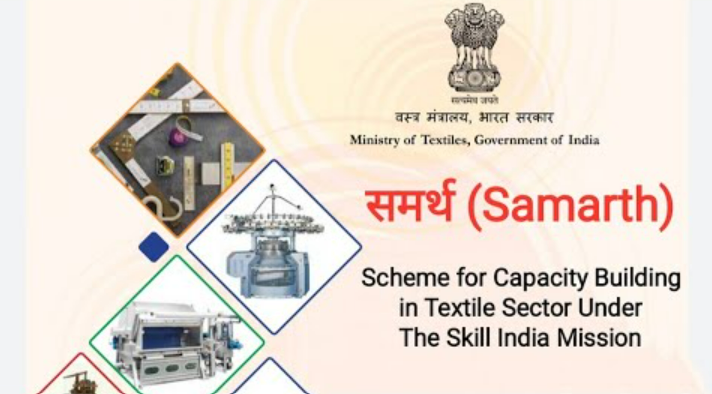Description

Disclaimer: Copyright infringement not intended.
Context
- Out of the skilling target of 3.47 lakh beneficiaries allocated so far, 1.5 lakh beneficiaries have been provided training under the Samarth Scheme.
Samarth Scheme Details
- Samarth is a demand-driven and placement-oriented umbrella skilling program of Ministry of Textiles.
- The implementation period of the scheme is up to March 2024.
- The scheme was formulated under the broad skilling policy framework adopted by M/o Skill Development & Entrepreneurship.
Aim of the Scheme
- Samarth aims to incentivize and supplement the efforts of the industry in creating jobs in the organized textile and related sectors, covering the entire value chain of textiles, excluding Spinning and Weaving.
.jpeg)
Objectives of Samarth Scheme
The main objectives of the Samarth scheme are:
- Providing skilling programmes that are National Skills Qualifications Framework (NSQF) certified and are based on the demand and placement driven.
- To assist and enhance the sector's job-creation initiatives.
- Organise around the textile industry, omitting spinning, weaving, and related sectors.
- To improve and strengthen one's talents in the traditional industry that comprises jute, handicrafts, sericulture, and handloom.
- To guarantee that everyone in the nation has a sustainable means of subsistence whether they are self-employed or engaged for pay.
Implementation
- The scheme is implemented through Implementing Partners (IPs) comprising of Textile Industry/ Industry Associations, State government agencies and Sectoral Organizations of Ministry of Textiles like DC/ Handloom, DC/Handicrafts and Central Silk Board.
The organisations listed below will carry out the skill-building initiatives for the Samarth scheme:
- Institutions or groups connected to the textiles industry and the state or federal governments that have training resources and connections to the textile industry for job placement.
- Reputable training facilities, NGOs, groups, trusts, and corporations.
- Businesses, startups, and business owners who have a textile industry agency agreement.
Features of Samarth Scheme
- The training programme and course curriculum have been rationalized keeping in view the technological and market demand of the domestic and international economies.
- In addition to the entry level skilling, a special provision for upskilling/ re-skilling programme has also been operationalized under the scheme towards improving the productivity of the existing workers in Apparel & Garmenting segments.
- Samarth also caters to the upskilling/ re-skilling requirement of traditional textile sector such as handloom, handicraft, silk and jute.
- A total of 184 courses aligned with National Skill Qualification Framework (NSQF) have been adopted under the scheme across various textile segments covering traditional sector like Handloom/ Handicrafts to conventional sector like Garmenting to advanced sector like Technical Textiles.

Execution and Monitoring
- There is an end-to-end Digital solution for ease of implementation and monitoring.
- Samarth has been formulated with advanced features such as Aadhaar Enabled Biometric Attendance System (AEBAS), Training of Trainers (ToT), CCTV recording of the training programme, a dedicated call centre with helpline number, mobile app, Web-based Management Information System (MIS), on-line monitoring of the training process etc.
- The State, District, Training Centre-wise information/ data in the dashboard is available in the public domain.
- Employment linkage is mandated in the courses under the organized textile sector with mandatory placement 70% in entry-level & 90% for Upskilling programmes.
- Also, a mobile app for physical verification of the training centres with Geo-tagging/time-stamped photographs.
- Besides, third-party assessment trainees and QR code-enabled e-certificate has been operationalized for this purpose. Additionally, all trainers are accredited through the Training of Trainers (ToT) (Online & Offline mode) programme through due process.
Evaluation of the Scheme
- The scheme has been penetrated across 28 States and 6 Union territories of the country and caters to all sections of society including SC, ST and other marginalized categories.
- Out of the skilling target of 3.47 lakh beneficiaries allocated so far, 1.5 lakh beneficiaries have been provided training.
- More than 85% of the beneficiaries trained so far under the scheme are women.
- More than 70% of the beneficiaries trained in organized sector courses have been provided placement.
|
PRACTICE QUESTION
Q) Which of the following statements is/are correct?
a. Samarth is a demand-driven and placement-oriented umbrella skilling program of the Ministry of Skill Development and Entrepreneurship.
b. Samarth aims to incentivize and supplement the efforts of the industry in creating jobs in the Manufacturing Sector.
i. Only a
ii. Only b
iii. Both a and b
iv. None of the above.
Answer: Option iv
|

https://pib.gov.in/PressReleasePage.aspx?PRID=1903910














